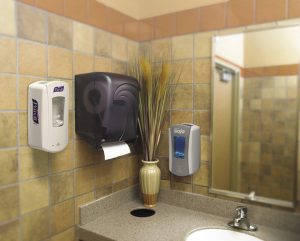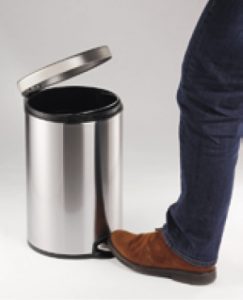He also predicts an increase in the automation of other areas of the washroom. “We have already seen an increase in the last few years of automatic toilet flush and more recently airplane style flush devices on toilets that not only reduce water consumption, but also decrease the amount of airborne particulate being realised at point of flush.”
Although the use of automatic doors at the entrance to toilets may sound like a solution to touching surfaces on the way out of the loo, (rather says Doak like those used in trains), the washroom experts concurred that privacy issues might make this an innovation too far. Instead, suggests Gilliard, there are ways in which FMs can make doors easier to open when exiting with clean, freshly washed hands. “For example, brackets can be fitted so that a door can be opened with your forearm, or double swing doors can be fitted. Either option can reduce the spread of dirt and germs and also make for a washroom that is easier to clean.”
CLEAN PRACTICES
 Aside from the increasing adoption of automation, more stringent cleaning practices will be the best way to keep buildings infection-free, and FMs will need to increase the amount of cleaning and checking of washrooms to achieve this. According to Wakefield: “It is now more important than ever that washroom facilities are in good working order, and remain well-maintained, well-stocked, and regularly monitored. After all, people are unable to wash their hands if the soap has dispenser has run empty.”
Aside from the increasing adoption of automation, more stringent cleaning practices will be the best way to keep buildings infection-free, and FMs will need to increase the amount of cleaning and checking of washrooms to achieve this. According to Wakefield: “It is now more important than ever that washroom facilities are in good working order, and remain well-maintained, well-stocked, and regularly monitored. After all, people are unable to wash their hands if the soap has dispenser has run empty.”
Doak agrees that although there will still need to be a human element for this to happen, the number of users could be monitored automatically, “avoiding unnecessary checks if the facilities have not been used very frequently.”
Gillard advises that FMs should plan and ensure a regular and thorough cleaning schedule is followed; and that washrooms are checked even more regularly to prevent toilet tissue, soap or hand drying dispensers from running empty. “To help avoid this situation, FMs can install high capacity toilet roll or continuous towel roll systems. This will also help minimise labour intensive repeat refilling of dispensers throughout the day.”
WASTE DISPOSAL
As Doak explains, with increased hand washing being encouraged, it is likely that washroom waste will also increase, not only through paper towels and tissues, but also discarded PPE such as masks and gloves.
He advises that: “Bins should be emptied more frequently, to ensure they don’t overfill and become difficult to manage, with the liners being sealed correctly and the correct PPE worn. Collections should be increased to ensure waste is not stored on site any longer than necessary, thus cutting down infection risk.
 “Offensive waste streams should be introduced into washrooms if not already in place and appropriate receptacles should be used (such as pedal or auto bins) to ensure waste can be deposited without the need to touch any lids or surfaces unnecessarily. Regular sanitisation of these receptacles should also become part of the new, enhanced cleaning regime.”
“Offensive waste streams should be introduced into washrooms if not already in place and appropriate receptacles should be used (such as pedal or auto bins) to ensure waste can be deposited without the need to touch any lids or surfaces unnecessarily. Regular sanitisation of these receptacles should also become part of the new, enhanced cleaning regime.”
Another area which might need consideration is the materials used to carry out the cleaning of washrooms. Gillard advocates using a combined detergent disinfectant solution (at a dilution of 1,000 parts per million available chlorine) following Government advice to ‘think one site, one wipe, in one direction.’(v)
She adds that “disposable cloths or paper roll, and disposable mop heads should be used to clean all hard surfaces, floors, chairs, and sanitary fittings. Any used cloths and mop heads must be put into waste bags and disposed of as normal.
“If an individual has displayed symptoms of COVID-19, any waste from cleaning of areas where they have been (including PPE, disposable cloths and used tissues) should be put in a plastic rubbish bag and tied when full. The plastic bag should then be placed in a second bin bag and tied, and placed in a suitable and secure place. It should be marked for storage. After 72 hours, or if the individual receives a negative test result before then, it can be placed in the normal, communal waste.”
She concludes that FMs should strive to offer a welcoming and pleasant washroom experience, because this helps to promote good hand hygiene.
“With all these practices in place, providing clean and hygienic facilities will be even more critical for business, as customers often judge the overall perception of an organisation based on their experiences in the washroom.”
(iii) 60–70% of women and 50–60% of men report having sensitive skin to some degree www.ncbi.nlm.nih.gov/pmc/articles/PMC6533878/)
(iv) Aerosol and Surface Stability of HCoV-19 (SARS-CoV-2) as Compared With SARS-CoV-1 www.nejm.org/doi/full/10.1056/NEJMc2004973





